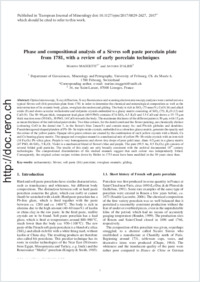Phase and compositional analysis of a Sèvres soft paste porcelain plate from 1781, with a review of early porcelain techniques
- Maggetti, Marino Department of Geosciences, Mineralogy and Petrography, University of Fribourg, Switzerland
- D’Albis, Antoine 34 rue Saint-Lazare, Limoges, France
-
16.02.2017
Published in:
- European Journal of Mineralogy. - 2017, vol. 29, no. 3, p. 347-367
English
Optical microscopy, X-ray diffraction, X-ray fluorescence and scanning electron microscopy analyses were carried out on a typical Sèvres soft (frit) porcelain plate from 1781 in order to determine the chemical and mineralogical composition as well as the microstructure of its ceramic body, glaze, overglaze decoration and gilding. The body is rich in SiO₂ (73 mass%), CaO (16) and alkali oxide (8) and shows acicular wollastonite and tridymite crystals embedded in a glassy matrix consisting of SiO₂ (75), K₂O (12) and CaO (9). The 50–90 µm thick, transparent lead glaze (40.9 PbO) contains 47.6 SiO₂, 6.5 K₂O and 3.5 CaO and shows a 35–75 µm thick reaction zone (50 SiO₂, 30 PbO, 14 CaO) towards the body. The maximum thickness of the different paints is 50 µm, with 15 µm as mean thickness of the individual paint stroke. Two blue colours, for the dentil comb and the flower painting, are chemically distinct (colouring CoO in the dental rim 7, in the flower’s blue 2 mass%) and contain many As- and Pb- rich globules and dendrites. Pseudohexagonal shaped platelets of Pb–Sb–Sn triple oxide crystals, embedded in a colourless glassy matrix, generate the opacity and the colour of the yellow paints. Opaque olive green colours are created by the combination of such yellow crystals with a bluish, Cu and Co bearing glassy matrix. The opaque red overglaze enamel is a mechanical mix of yellow Pb–Sb oxide crystals with an iron- rich (16 Fe₂O₃) Pb–silica glass. Purple is very homogeneous and shows tiny drops of pure gold (max. diam. 0.5 µm) in a glassy matrix (47 PbO, 46 SiO₂, 5 K₂O). Violet is a mechanical blend of flower’s blue and purple. The pure (99.5 Au, 0.5 Fe₂O₃) gilt consists of several folded gold particles. The results of this study are only broadly consistent with the archival documented 18th century technologies. The compositional dissimilarities of the studied enamels suggest that each colour was independently fritted. Consequently, the original colour recipes written down by Hellot in 1753 must have been modified in the 30 years since then.
- Faculty
- Faculté des sciences et de médecine
- Department
- Département de Géosciences
- Language
-
- English
- Classification
- Mineralogy
- License
- License undefined
- Identifiers
-
- RERO DOC 279097
- DOI 10.1127/ejm/2017/0029-2627
- Persistent URL
- https://folia.unifr.ch/unifr/documents/305196
Statistics
Document views: 144
File downloads:
- mag_pca.pdf: 294
